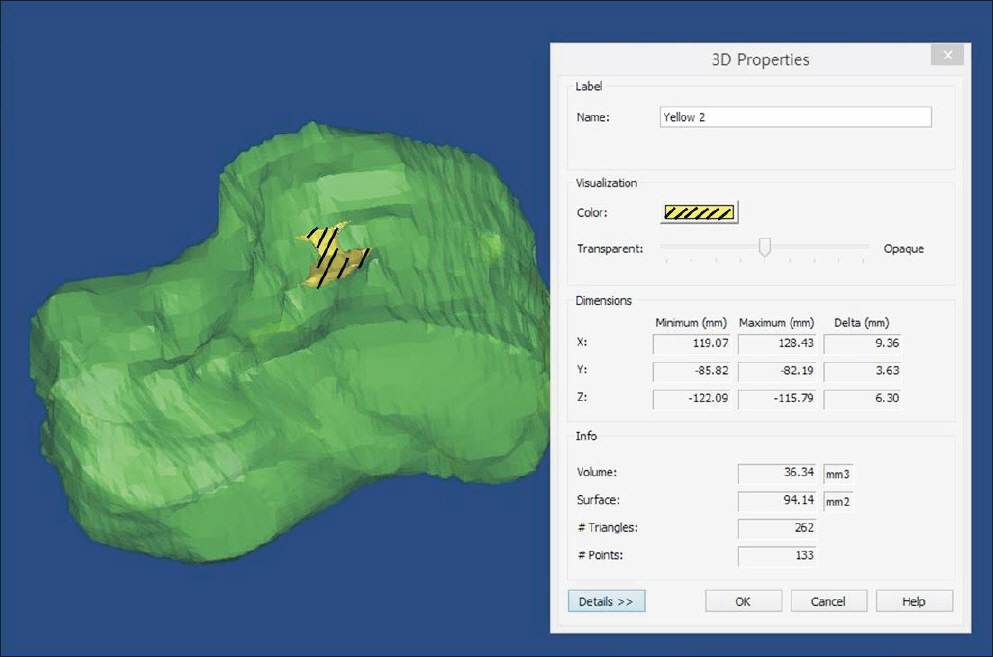J Korean Foot Ankle Soc.
2015 Dec;19(4):161-164. 10.14193/jkfas.2015.19.4.161.
Three-Dimensional Volume Analysis of Partial Avascular Necrosis after Talar Neck Fracture
- Affiliations
-
- 1Department of Orthopaedic Surgery, School of Medicine, Chosun University, Gwangju, Korea. leejy88@chosun.ac.kr
- KMID: 2132458
- DOI: http://doi.org/10.14193/jkfas.2015.19.4.161
Abstract
- PURPOSE
The purpose of this study is to define the geographic patterns of partial avascular necrosis (AVN) of the talar body and to determine whether there were any predictors of both the location and occurrence of partial AVN.
MATERIALS AND METHODS
Nineteen patients with fracture of the talar neck treated by open reduction and internal fixation and followed up for more than 1 year were analyzed. The radiographs were examined 6 to 8 weeks after the operation for Hawkins sign and if it was not observed, magnetic resonance scans were performed. The three-dimensional analysis was performed using Mimics 17.0 (Materialise). The incidence of collapse and time to operative intervention was recorded.
RESULTS
Partial AVN of the talar body was observed in six out of 19 patients. The avascular segment of the talar body was located predominantly in the anterolateral portion. The average volume of the avascular segment was 289 mm3, and it occupied 1% of total volume of the talus, and 10% of the talar dome. Collapse occurred in one patient in the area of the avascular process. There were no observable trends with regard to Hawkins classification, incidence of collapse, or time to operative intervention to the location of the avascular segment.
CONCLUSION
Partial AVN can occur after fracture of the talar neck. The predominant location of the avascular segment was the anterolateral portion of the talar body. This information may be helpful to understanding the process of avascular necrosis of the talar body.
Keyword
Figure
Reference
-
References
1. Archdeacon M, Wilber R. Fractures of the talar neck. Orthop Clin North Am. 2002; 33:247–62.
Article2. Donnelly EF. The Hawkins sign. Radiology. 1999; 210:195–6.
Article3. Hawkins LG. Fractures of the neck of the talus. J Bone Joint Surg Am. 1970; 52:991–1002.
Article4. Henderson RC. Posttraumatic necrosis of the talus: the Hawkins sign versus magnetic resonance imaging. J Orthop Trauma. 1991; 5:96–9.5. Penny JN, Davis LA. Fractures and fracture-dislocations of the neck of the talus. J Trauma. 1980; 20:1029–37.
Article6. Babu N, Schuberth JM. Partial avascular necrosis after talar neck fracture. Foot Ankle Int. 2010; 31:777–80.
Article7. Comfort TH, Behrens F, Gaither DW, Denis F, Sigmond M. Longterm results of displaced talar neck fractures. Clin Orthop Relat Res. 1985; 199:81–7.
Article8. Tehranzadeh J, Stuffman E, Ross SD. Partial Hawkins sign in fractures of the talus: a report of three cases. AJR Am J Roentgenol. 2003; 181:1559–63.
Article9. Peterson L, Goldie IF, Irstam L. Fracture of the neck of the talus. A clinical study. Acta Orthop Scand. 1977; 48:696–706.10. Tezval M, Dumont C, Stürmer KM. Prognostic reliability of the Hawkins sign in fractures of the talus. J Orthop Trauma. 2007; 21:538–43.
Article11. Gelberman RH, Mortensen WW. The arterial anatomy of the talus. Foot Ankle. 1983; 4:64–72.
Article12. Haliburton RA, Sullivan CR, Kelly PJ, Peterson LF. The extraosseous and intraosseous blood supply of the talus. J Bone Joint Surg Am. 1958; 40:1115–20.
Article13. Kelly PJ, Sullivan CR. Blood supply of the talus. Clin Orthop Relat Res. 1963; 30:37–44.14. Mulfinger GL, Trueta J. The blood supply of the talus. J Bone Joint Surg Br. 1970; 52:160–7.
Article15. Peterson L, Goldie I, Lindell D. The arterial supply of the talus. Acta Orthop Scand. 1974; 45:260–70.16. Thordarson DB, Triffon MJ, Terk MR. Magnetic resonance imaging to detect avascular necrosis after open reduction and internal fixation of talar neck fractures. Foot Ankle Int. 1996; 17:742–7.
Article
- Full Text Links
- Actions
-
Cited
- CITED
-
- Close
- Share
- Similar articles
-
- Avascular Necrosis After the Fracture of the Neck of the Talus
- Fracture of the Neck of the Talus
- Avascular Necrosis after Operative Treatment for Fracture and Dislocations of the Talar Neck
- Long Term Follow-up of Avascular Necrosis after Talar Fracture and Dislocation: 5 Cases
- Clinical Observation for the Treatment of Talus Fracture




